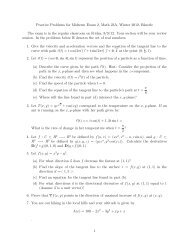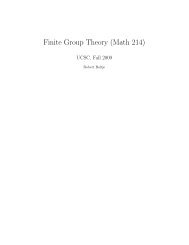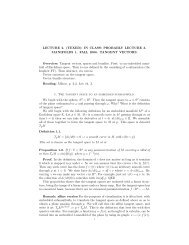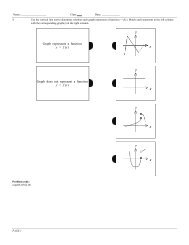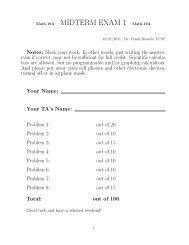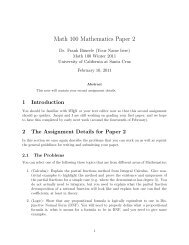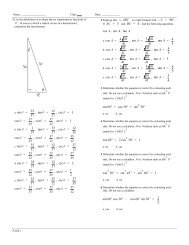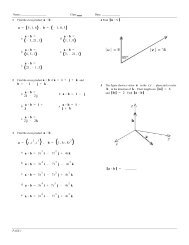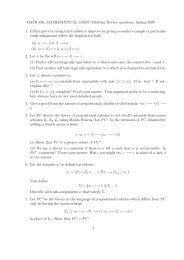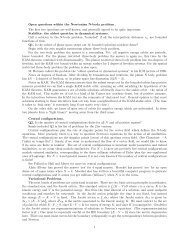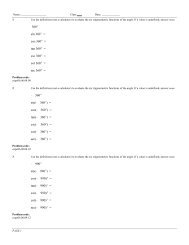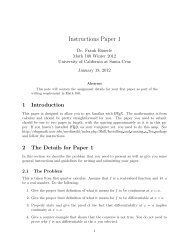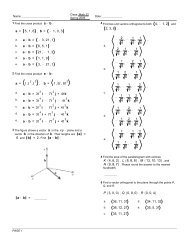MATH 23A, REVIEW PROBLEMS FOR THE FINAL (1) Find the ...
MATH 23A, REVIEW PROBLEMS FOR THE FINAL (1) Find the ...
MATH 23A, REVIEW PROBLEMS FOR THE FINAL (1) Find the ...
Create successful ePaper yourself
Turn your PDF publications into a flip-book with our unique Google optimized e-Paper software.
<strong>MATH</strong> <strong>23A</strong>, <strong>REVIEW</strong> <strong>PROBLEMS</strong> <strong>FOR</strong> <strong>THE</strong> <strong>FINAL</strong><br />
(1) <strong>Find</strong> <strong>the</strong> equation of <strong>the</strong> tangent plane to <strong>the</strong> surface determined by<br />
<strong>the</strong> equation y 3 x − xz 2 + z 5 = 9 at <strong>the</strong> point P = (−1, 3, 2).<br />
(2) If <strong>the</strong> vector v = (a 2 , −2a, −1) lies in <strong>the</strong> tangent plane to <strong>the</strong> surface<br />
z = e x /y at <strong>the</strong> point (0, 1, 1), what is <strong>the</strong> value of <strong>the</strong> constant a?<br />
(3) <strong>Find</strong> <strong>the</strong> directional derivative of <strong>the</strong> function f(x, y) = ln (x 2 + y 2 )<br />
at <strong>the</strong> point (−1, 1) along <strong>the</strong> direction of <strong>the</strong> vector v = (3i + 4j)/5.<br />
(4) <strong>Find</strong> Df and <strong>the</strong> Hessian matrix Hf for <strong>the</strong> following functions at<br />
<strong>the</strong> given points. <strong>Find</strong> also <strong>the</strong> second order Taylor formula for <strong>the</strong>se<br />
functions at <strong>the</strong> given points.<br />
(a) f(x, y) = (x − y) 2 ; (0, 0)<br />
(b) f(x, y) = e (y+3)2 cos x; (0, −3)<br />
(c) f(x, y) = sin x<br />
y<br />
; (π/2, 1)<br />
(5) <strong>Find</strong> <strong>the</strong> critical points of <strong>the</strong> functions (a)-(e), and classify <strong>the</strong>m.<br />
(a) f(x, y) = 3y 2 + 2xy + 2y + x 2 + x + 4<br />
(b) f(x, y) = e 1+x2 −y 2<br />
(c) f(x, y) = (x − y)(xy − 1)<br />
(d) f(x, y) = x 3 + y 2 − 6xy + 6x + 3y<br />
(e) f(x, y) = x sin y<br />
(6) Determine whe<strong>the</strong>r f(x, y) = x 4 y 4 has a local and an absolute maximum,<br />
a minimum, or nei<strong>the</strong>r.<br />
(7) <strong>Find</strong> <strong>the</strong> absolute maximum and minimum values for f(x, y) =<br />
cos x + sin y on <strong>the</strong> rectangle R = [0, 2π] × [0, 2π].<br />
(8) <strong>Find</strong> <strong>the</strong> point in <strong>the</strong> plane 2x − y + 2z = 20 nearest <strong>the</strong> origin.<br />
(9) <strong>Find</strong> <strong>the</strong> points on <strong>the</strong> ellipse x 2 + 2y 2 = 1 where f(x, y) = xy has<br />
its extreme values.<br />
(10) <strong>Find</strong> <strong>the</strong> absolute maximum and minimum values for f(x, y) = x 2 +<br />
xy + y 2 on <strong>the</strong> unit disk D = {(x, y)|x 2 + y 2 ≤ 1}. Use <strong>the</strong> method<br />
of Lagrange multipliers on <strong>the</strong> boundary.<br />
(11) <strong>Find</strong> <strong>the</strong> absolute maximum and minimum values for f(x, y) = x 2 +<br />
3y 2 + 2y on <strong>the</strong> unit disk D = {(x, y)|x 2 + y 2 ≤ 1}. Use <strong>the</strong> method<br />
of Lagrange multipliers on <strong>the</strong> boundary.<br />
(12) <strong>Find</strong> <strong>the</strong> arc-length of <strong>the</strong> graph of y = cosh x for − ln 2 ≤ x ≤ ln 2.<br />
(13) <strong>Find</strong> <strong>the</strong> arc-length of <strong>the</strong> path c(t) = (2 cos t, 2 sin t, t) for 0 ≤ t ≤<br />
2π.<br />
(14) Show that <strong>the</strong> equation x 4 yz + y 4 + z 4 = 1 is solvable for z as a<br />
function of (x, y) near (1, 1, 0). Compute ∂z/∂x and ∂z/∂y at (1, 1).<br />
1
2 <strong>MATH</strong> <strong>23A</strong>, <strong>REVIEW</strong> <strong>PROBLEMS</strong> <strong>FOR</strong> <strong>THE</strong> <strong>FINAL</strong><br />
(15) Compute <strong>the</strong> divergence and curl of <strong>the</strong> following vector fields F,<br />
i.e., find ∇ · F and ∇ × F.<br />
(a) F(x, y, z) = x(sin y)i + cos (x − z)j + zk<br />
(b) F(x, y, z) = (x − y)i + (x + y)j<br />
(c) F(x, y, z) = ln(z + y 2 )i + e x−y j + z 3 yk<br />
(16) Show that F(x, y) = (x − y)i + (y − x)j is a gradient vector field.<br />
<strong>Find</strong> a function f such that F = ∇f.<br />
(17) Let F(x, y) = xi + x 2 j be <strong>the</strong> velocity field of a fluid in <strong>the</strong> plane.<br />
(a) Show that c(t) = (e t , e 2t /2) is a flow line of F.<br />
(b) Is F a gradient vector field? Justify your answer.<br />
(c) Is <strong>the</strong> fluid expanding or compressing as it moves? Justify your<br />
answer.<br />
(18) Let F(x, y) = yi + xj be <strong>the</strong> velocity field of a fluid in <strong>the</strong> plane.<br />
(a) Show that c(t) = (2e t − e −t , 2e t + e −t ) is a flow line of F.<br />
(b) Is F a gradient vector field? Justify your answer.<br />
(c) Is <strong>the</strong> fluid expanding or compressing as it moves? Justify your<br />
answer.<br />
There will also be True/False questions on <strong>the</strong> final exam.



